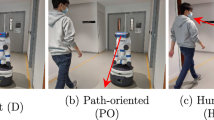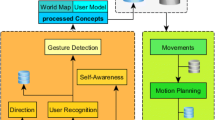Abstract
With an increase in their capabilities, robots start to play a role in everyday settings. This necessitates a step from a robot-centered (i.e., teaching humans to adapt to robots) to a more human-centered approach (where robots integrate naturally into human activities). Achieving this will increase the effectiveness of robot usage (e.g., shortening the time required for learning), reduce errors, and increase user acceptance. Robotic camera control will play an important role for a more natural and easier-to-interpret behavior, owing to the central importance of gaze in human communication. This study is intended to provide a first step towards improving camera control by a better understanding of human gaze behavior in social situations. To this end, we registered the eye movements of humans watching different types of movies. In all movies, the same two triangles moved around in a self-propelled fashion. However, crucially, some of the movies elicited the attribution of mental states to the triangles, while others did not. This permitted us to directly distinguish eye movement patterns relating to the attribution of mental states in (perceived) social situations, from the patterns in non-social situations. We argue that a better understanding of what characterizes human gaze patterns in social situations will help shape robotic behavior, make it more natural for humans to communicate with robots, and establish joint attention (to certain objects) between humans and robots. In addition, a better understanding of human gaze in social situations will provide a measure for evaluating whether robots are perceived as social agents rather than non-intentional machines. This could help decide which behaviors a robot should display in order to be perceived as a social interaction partner.
Similar content being viewed by others
References
Deubel H, Schneider WX (1996) Vis Res 36(12):1827
Hunt AR, von Mühlenen A, Kingstone A (2007) J Exp Psychol Hum Percept Perform 33(2):271. doi:10.1037/0096-1523.33.2.271
Breazeal C, Scassellati B (1999) In: Proceedings of the 1999 IEEE/RSJ international conference on intelligent robots and systems, pp 858–863
Persson P, Laaksolahti J, Lönnqvist P (2001) IEEE Trans Syst Man Cybern Part A Syst Humans 31(3):349
Ballard DH, Hayhoe MM, Pook PK, Rao RP (1997) Behav Brain Sci 20(4):723
Johnson S, Slaughter V, Carey S (1998) Dev Sci 1:233
Nagai Y, Hosoda K, Morita A, Asada M (2003) Connect Sci 15:211
Triesch J, Teuscher C, Deák GO, Carlson E (2006) Dev Sci 9(2):125. doi:10.1111/j.1467-7687.2006.00470.x
Nation K, Penny S (2008) Dev Psychopathol 20(1):79. doi: 10.1017/S0954579408000047
Krach S, Hegel F, Wrede B, Sagerer G, Binkofski F, Kircher T (2008) PLoS ONE 3(7):e2597. doi:10.1371/journal.pone.0002597
Birmingham E, Bischof WF, Kingstone A (2008) Vis Cogn 16(2/3):341
Fletcher-Watson S, Findlay JM, Leekam SR, Benson V (2008) Perception 37(4):571
Land MF, Furneaux S (1997) Philos Trans R Soc Lond B 352(1358):1231. doi:10.1098/rstb.1997.0105
Heider F, Simmel M (1944) Am J Psychol 57(2):243
Tversky B, Hard BM (2009) Cognition 110(1):124. doi:10.1016/j.cognition.2008.10.008
Csibra G (2008) Cognition 107(2):705. doi:10.1016/j.cognition.2007.08.001
Weizenbaum J (1966) In: Communications of the ACM, vol 9, ed. by AG Oettinger (1966), vol 9, pp 36–45
Duffy B (2003) Anthropomorph Soc Robot 42(3–4):177
Hommel B, Müsseler J, Aschersleben G, Prinz W (2001) Behav Brain Sci 24(5):849
Kilner JM, Paulignan Y, Blakemore SJ (2003) Curr Biol 13(6):522
Rizzolatti G, Craighero L (2004) Ann Rev Neurosci 27:169. doi:10.1146/annurev.neuro.27.070203.144230
Gallese V, Goldman A (1998) Trends Cogn Sci 2(12):493
Gallese V (2007) Philos Trans R Soc Lond B Biol Sci 362(1480):659. doi:10.1098/rstb.2006.2002
Pozzo T, Papaxanthis C, Petit JL, Schweighofer N, Stucchi N (2006) Behav Brain Res 169(1):75. doi:10.1016/j.bbr.2005.12.005
Craighero L, Bonetti F, Massarenti L, Canto R, Destro MF, Fadiga L (2008) Brain Res Bull 75(6):770. doi:10.1016/j.brainresbull.2008.01.014
Kilner J, de C Hamilton AF, Blakemore SJ (2007) Soc Neurosci 2(34):158. doi:10.1080/17470910701428190
Grosjean M, Zwickel J, Prinz W (2009) Psychol Res/Psychol Forsch 73(1):3. doi:10.1007/s00426-008-0146-6
Gazzola V, Rizzolatti G, Wicker B, Keysers C (2007) Neuroimage 35(4):1674. doi:10.1016/j.neuroimage.2007.02.003
Stanley J, Gowen E, Miall RC (2007) J Exp Psychol Human Percept Perform 33(4):915. doi:10.1037/0096-1523.33.4.915
Biocca F, Harms C, Burgoon JK (2003) Presence 12(5):456
Dennett DC (1989) The intentional stance. MIT Press, Cambridge
Zacks JM (2004) Cogn Sci 28(6):979
Hayhoe M, Ballard D (2005) Trends Cogn Sci 9(4):188. doi: 10.1016/j.tics.2005.02.009
Rothkopf CA, Ballard DH, Hayhoe MM (2007) J Vis 7(14):1. doi:10.1167/7.14.16
Dautenhahn K, Werry I (2002) In: Proceedings of the 2002 IEEE/RSJ intl conference on intelligent robots and systems, pp 1132–1138
Brenner L, Turner K, Müller RA (2007) J Autism Dev Disord 37(7):1289. doi:10.1007/s10803-006-0277-9
Klein A, Zwickel J, Prinz W, Frith U (2009) Q J Exp Psychol (Colchester) 62(6):1189. doi:10.1080/17470210802384214
Abell F, Happé F, Frith U (2000) Cogn Dev 15(1):1
Greenhouse S, Geisser S (1959) Psychometrika 24(2):95
Breazeal C, Fitzpatrick P (2000) In: Proceedings of the AAAI fall symposium socially intelligent agents: the human in the loop
Irwin DE (2004) Fixation location and fixation duration as indices of cognitive processing. In: The interface of language, vision, and action. Psychology Press, New York, pp 105–133
Underwood G, Jebbett L, Roberts K (2004) Q J Exp Psychol A 57(1):165. doi:10.1080/02724980343000189
Carroll PJ, Young JR, Guertin MS (1992) Visual analysis of cartoons: a view from the far side. In: Eye movements and visual cognition. Scene perception and reading. Springer, New York, pp 444–461
Fehd HM, Seiffert AE (2008) Cognition 108(1):201. doi: 10.1016/j.cognition.2007.11.008
Bock SW, Dicke P, Thier P (2008) Vis Res 48(7):946. doi: 10.1016/j.visres.2008.01.011
Miyauchi D, Sakurai A, Nakamura A, Kuno Y (2004) In: CHI ’04: CHI ’04 extended abstracts on Human factors in computing systems. ACM, New York, pp 1099–1102
Author information
Authors and Affiliations
Corresponding author
Rights and permissions
About this article
Cite this article
Zwickel, J., Müller, H.J. Eye Movements as a Means to Evaluate and Improve Robots. Int J of Soc Robotics 1, 357–366 (2009). https://doi.org/10.1007/s12369-009-0033-3
Accepted:
Published:
Issue Date:
DOI: https://doi.org/10.1007/s12369-009-0033-3




